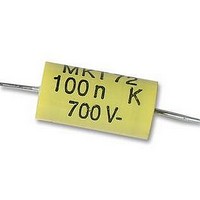26231941 Crouzet USA, 26231941 Datasheet - Page 73

26231941
Manufacturer Part Number
26231941
Description
CAPACITOR, MOTOR MEDIUM TORQUE CAPACITOR, MOTOR MEDIUM TORQUE
Manufacturer
Crouzet USA
Datasheet
1.26231909.pdf
(196 pages)
Specifications of 26231941
Capacitance
0.1UF
Voltage Rating, Dc
700V
Capacitor Dielectric Type
POLYPROPYLENE
Tolerance,
10%
Tolerance, -
10%
Temp, Op. Max
85(DEGREE C)
Temp, Op. Min
0(DEGREE
- Current page: 73 of 196
- Download datasheet (6Mb)
2.2. Braking:
Braking means absorbing the energy of the mechanical system. There
are several different types of braking, depending on the use made of
this absorbed energy:
Regenerative braking converts the energy of the system into electrical
current, which will be directed to the motor power supply.
Apart from batteries, most commercially available power supplies do
not accept this type of current feedback (they are known as ‘non-rever-
sible’). It is therefore necessary to ensure that the directed current can
be consumed by another device, without which the power supply may
be damaged. This braking mode is offered as an option on Crouzet bru-
shless motors, but must be used with caution.
Crouzet brushless motors have braking ‘without energy rejection’ as
standard. This means that on braking the kinetic energy of the system
is converted into heat inside the motor itself, with no feedback to the
power supply. This is the most suitable type of braking for most
applications.
However, if there is prolonged braking, the heat that is generated may
trip the thermal protection of the motor. For high inertia applications, or
operation as a generator, PLEASE CONSULT CROUZET. Depending
on the circumstances, our specialists will advise you to select either 2-
quadrant regulation, or braking with energy rejection.
2.3. Control by PWM
PWM (Pulse Width Modulation) control is a method of indicating the
speed setpoint to the motor. A PWM control motor should be chosen in
the following cases:
- Control by CROUZET Millenium II logic controllers (see MOTOMATE
information)
- Control by PLC with PWM outputs
- Control by digital control system
PWM control consists of pulse trains of fixed frequency (Period "T") but
variable width ("Ton" period of the pulse). The speed setpoint depends
on the Ton/T ratio. However it is independent of the voltage or frequen-
cy of the pulses, within the limits of the stated specifications.
Ton/T = 0%
Ton/T = 100%
Ton/T = 50%
2.4. Control by 0-10V
0-10V voltage control is the other method of indicating the speed set-
point to the motor. A 0-10V input motor should be chosen in the follo-
wing cases:
- Control by potentiometer
- Control by PLC with analogue converter outputs
- Control by analogue control system
In this type of control, the speed setpoint depends on the voltage U at
the speed setpoint input:
U = 0
U = 10V
U = 5V
V
T
Speed setpoint = 0
Speed setpoint = No-load speed of the motor
Speed setpoint = No-load speed of the motor/2
Ton
T
No-load speed
Ton
Speed setpoint = 0
Speed setpoint = No-load speed of the motor
Speed setpoint = No-load speed of the motor/2
T
Ton
0
T
10V
T
T
3.1. Operation
Torque limiting is used to deliberately check the motor at certain
moments in the operation of a system:
- If there is a risk of encountering an end stop or jamming, to prevent
damage to the system
- To maintain a force when the system is at an end stop
- To control the tension of an element located between two
moving motor
3.2. Torque limiting input (*)
This input can be controlled in 0-10V and in PWM, whatever type of
speed control is selected (Input impedance 16 k ohms. Minimum PWM
voltage 12 volts.
Frequency range 150 Hz - 1 kHz
- When the input is at 0 or not connected, the motor delivers up to
140% of its nominal torque
- When the input is at maximum (100% PWM or 10V), the motor deli-
vers around 30% of its nominal torque
When the torque limit is reached, the motor does not follow its speed
setpoint, but maintains a constant torque equal to this limit, as long as
its speed remains below the setpoint.
3.3. Limit reached alert output (*)
This output is at logic state 1 when the torque limit is reached.
IMPORTANT: This output is PNP type. Consult the wiring diagrams and
the precautions for use of this output in the motor specifications.
4.1. 30 watt motors
If the motor locks when it is controlled, a protection system cuts off the
power after a few seconds.
The motor can only restart when the On input changes to 0 then 1.
4.2. 80 watt motors
A temperature sensor incorporated in the motor switches the motor to
safety mode when the temperature exceeds a value which may dama-
ge it. When the trigger temperature is reached, the power is cut off,
which causes the motor to stop.
It can only restart when the temperature has fallen below the restart
temperature and the On input has changed to 0 then 1.
Torque limiting (*)
Built-in protection
Nominal
torque
Maximum torque
0 V
0 %
10 V
100 %
Torque limit
input
73
2
Related parts for 26231941
Image
Part Number
Description
Manufacturer
Datasheet
Request
R

Part Number:
Description:
SCREW SOCKET (OT08PC)
Manufacturer:
Crouzet USA
Datasheet:

Part Number:
Description:
PANEL PLATE FOR 813
Manufacturer:
Crouzet USA
Datasheet:

Part Number:
Description:
Controller; CTD46 Dual Display Temperature, 1/16 DIN, NEMA 4X, 110/220VAC
Manufacturer:
Crouzet USA
Datasheet:

Part Number:
Description:
11R1084
Manufacturer:
Crouzet USA
Datasheet:

Part Number:
Description:
11R1086
Manufacturer:
Crouzet USA
Datasheet:

Part Number:
Description:
11R1087
Manufacturer:
Crouzet USA
Datasheet:

Part Number:
Description:
11R1089
Manufacturer:
Crouzet USA
Datasheet:

Part Number:
Description:
11R1078
Manufacturer:
Crouzet USA
Datasheet:

Part Number:
Description:
11R1079
Manufacturer:
Crouzet USA
Datasheet:










